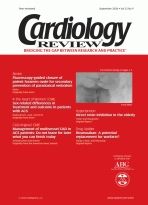Publication
Article
Cardiology Review® Online
Unusual appearance of a left ventricular mural thrombus
Author(s):
Postpartum cardiomyopathy is a serious disorder that can present from the third trimester to up to 5 months after pregnancy. Although spontaneous resolution of cardiac function occurs in more than half of patients (over a period of 6-12 months), the balance is left with persistent cardiac dysfunction. Cardiac dysfunction results in signs and symptoms of left heart failure, formation of apical or left ventricular thrombi, and arrhythmias and requires management similar to that in patients with nonischemic dilated cardiomyopathy.
Presentation and evaluation
A 36-year-old female presented 3 weeks after cesarean section with fatigue, loss of appetite, and shortness of breath. She also had a cough productive of white sputum. Physical examination revealed an elevated jugular venous pressure, tachycardia, summation gallop, and pulmonary rales. No leg edema was noted. A clinical diagnosis of heart failure with pulmonary congestion was made. Because of the post-partum state, a computed tomography scan of the chest was ordered to rule out pulmonary embolus. No pulmonary emboli were found, but perihilar congestion suggestive of left ventricular failure was noted.
Diagnosis
An echocardiogram revealed severely reduced left ventricular systolic function with an ejection fraction of 20%. There was a large, mobile, loculated mass attached to the posterior and inferolateral wall of the left ventricle (Figures 1 and 2). The cystic nature of the mass was thought to be very unusual for a thrombus. However, the presence of severe systolic dysfunction increased the likelihood that the cystic structure was a thrombus. A diagnosis of postpartum cardiomyopathy with a left ventricular thrombus was made.
Figure 1. Apical 2-chamber view demonstrating the cystic thrombus attached to the
inferior wall.
Figure 2. Apical 4-chamber view demonstrating thrombus with cystic appearance.
Patient management and outcome
Anticoagulation was begun with enoxaparin and warfarin while her cardiomyopathy was treated with lisinopril, carvedilol, digoxin, furosemide, and potassium. The patient's symptoms improved significantly with this management. A follow-up echocardiogram obtained 1 week later showed complete resolution of the thrombus and an improved ejection fraction of 45%. No embolic events were noted clinically.
Discussion
Mural thrombi are usually protuberant in the acute stage and become laminar with time. In the very early stages of clot formation, imbalance between thrombogenic and thrombolytic factors could result in an unusual cystic appearance. It has been proposed that thrombin-activatable fibrinolysis inhibitor stabilizes the exterior of the clot while the inner core is lysed by plasmin, resulting in cystic clots.7 Thrombus in the form of highly mobile membranes, disappearing with anticoagulant therapy, has been reported as well.8 It appears that certain morphologic features of thrombus (cystic lesions and membranous lesions as opposed to protuberant masses) might suggest that the thrombus is in its early stage of formation and help in predicting complete resolution with anticoagulant therapy.
The unusual appearance in this case tempted us to consider metastatic choriocarcinoma as a differential diagnosis.9 We ruled out choriocarcinoma with a negative human chorionic gonadotropin assay.






